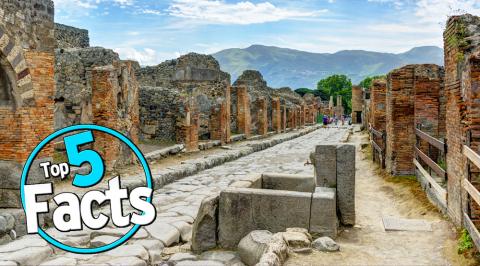Top 5 Pompeii Facts

The Mount Vesuvius eruption of 79 AD is one of the most famous natural disasters of European history, killing thousands of people and completely decimating several Roman settlements, including Pompeii. Welcome to WatchMojo's top 5 facts. In this installment, we're looking at the most amazing facts about Pompeii, arguably the most well known victim of that fateful day.
Special thanks to our user Corie John-William Taranto for submitting the idea using our interactive suggestion tool at http://www.WatchMojo.comsuggest
Top 5 Facts Pompeii
The Mount Vesuvius eruption of 79 AD is one of the most famous natural disasters of European history, killing thousands of people and completely decimating several Roman settlements, including Pompeii. Welcome to WatchMojo’s top 5 facts. In this installment, we're looking at the most amazing facts about Pompeii, arguably the most well known victim of that fateful day.
#5: Vesuvius’s Eruption Was More Powerful Than an Atomic Bomb
The power of Vesuvius’ eruption is almost impossible to imagine. Around 1:00pm, the mountain exploded and the entire cone was blown off, releasing a massive cloud of gas, ash, and stone into the air and turning the city dark as the debris blocked out the sun. Little Boy, the bomb that was dropped on Hiroshima in August 1945, is said to have been so powerful, that it left human-shaped imprints in the pavement. The bomb released energy equivalent to roughly 15 kilotons of TNT, which significantly destroyed the city within seconds. Vesuvius’ eruption, however, is estimated to have released 100,000 times more thermal energy than that.
#4: The Deceased Have Been Made into Body Casts
In a fascinating feat of archaeology, these body casts have preserved some of the victims’ final moments before death. During early excavations of Pompeii, empty voids in the ash were discovered with human remains in them. The Italian archaeologist Giuseppe Fiorelli deduced that these voids were left by the bodies of the pyroclastic flow victims and filled them with plaster, creating the first Pompeii body casts. These casts are so realistic that even various clothes and facial features are identifiable. Some of the more disturbing displays include an individual in a praying position and a child resting on their mother’s lap with a look of content frozen on their faces.
#3: Pompeii Cemeteries Also Served as Dumps
The graveyards of Pompeii weren't just for storing the dead. Archaeologists have found cemeteries throughout the city that have been littered with debris, including charred animal bones, broken pottery, and discarded tools. Research done by the University of Cincinnati reveals that the citizens of Pompeii had very lax rules about garbage disposal, and the city's cemeteries were placed alongside heavily-traveled roads and along city walls for everyone to see. As such, they concluded that the cemeteries were so heavily trashed because these Ancient Romans simply didn't care about where their garbage was discarded. In their eyes, a cemetery was as good a place as any.
#2: Vesuvius Gave Plenty of Warnings Before Erupting
You can't say that the people of Pompeii weren't warned. Seventeen years before the eruption, a major earthquake seriously damaged Pompeii, leaving the otherwise luxurious city in disarray and caused many citizens to flee. As 600 sheep were killed by poisonous gas in the air, some experts believe that this was an early sign of the mountain's awakening. While repairs were still being made in 79 AD, strange things began to happen around Pompeii: wells dried up, vines on the slopes of Vesuvius wilted and died, and there was a dramatic increase in seismic activity. Because tremors were considered normal for the region, the citizens simply shrugged their shoulders and carried on with business as usual. Besides, Pompeii was a popular vacation destination for Romans, and nothing kills a holiday vibe more than impending doom. Makes you wonder what it’s like to live on the edge of catastrophe, but carry on as though everything was fine.
#1: The People of Pompeii Were Weirdly Obsessed with Sex
Here in North America, we have this prudish legacy of puritanism that we’re still dealing with when it comes to sex. Not so in ancient Rome! In Pompeii, sex was a normal and everyday concept of life, and as such, the city was littered with symbols of it. Brothels were common, complete with obscene graffiti that is still legible today. Frescoes containing images of graphic sexual content abounded, phallic symbols adorned public areas, and there was even a statue made of the god Pan having sex with a goat. These findings were deemed so controversial and taboo that King Francis I of Naples had them locked away, holding them in the Secret Cabinet section of the Naples National Archaeological Museum due to their graphic nature. The cabinet was closed for nearly 100 years, although it was briefly opened in the ‘60s and finally re-opened for viewing in 2000. I guess modern Italy has that whole Catholic legacy thing to deal with.
So, do you want to go and visit Pompeii for yourself? How would you have reacted seeing a pyroclastic flow coming barreling towards you? For more sun-blocking top tens and garbage throwing top fives published every day, be sure to subscribe to Watchmojo.com.


 1
1
 0
0
 report
report